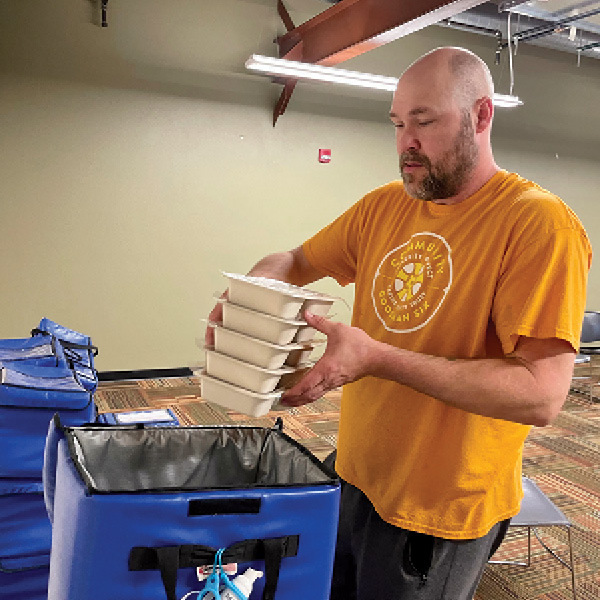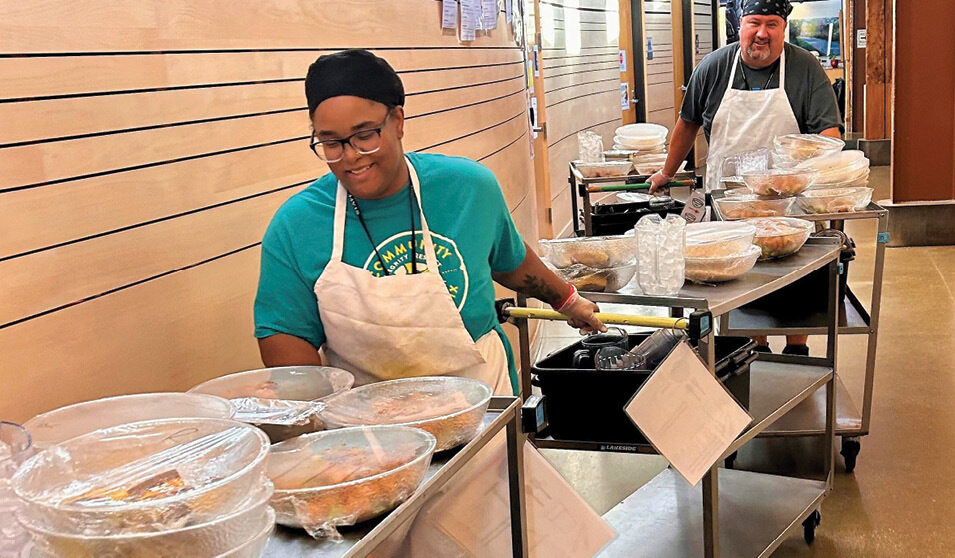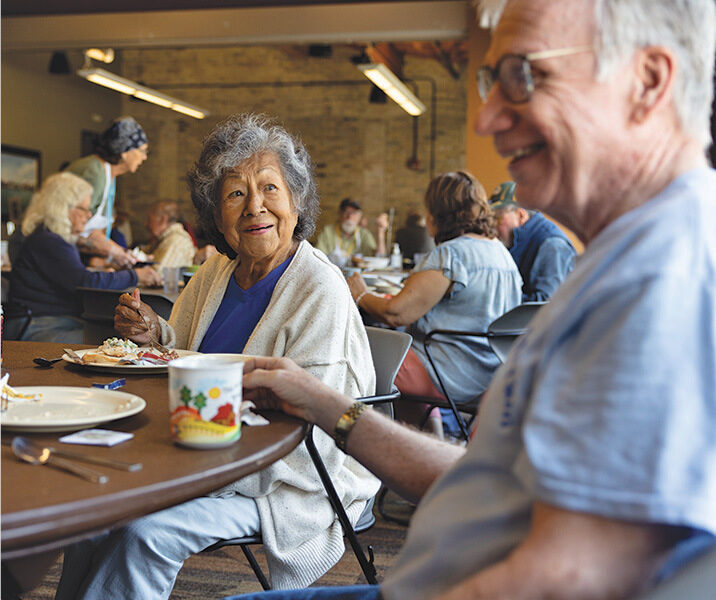By Ivy Fan, Eastside News
Every day, hundreds of voices float through the halls and rooms of the Goodman Community Center. Parents calling to their children during drop-off for early child care programs. Older adults bantering during a session of euchre. The building’s wooden curves swell with energy — new things to learn, old friends to greet, a rotating schedule of places to be. Quietly, beside all the hubbub, another flurry of orchestrated motion unfolds among stainless steel surfaces. Behind the scenes, this other group works to ensure these activities can happen, preparing for that moment when every voice falls silent, even if just for a second before rising again: mealtime.
GCC serves many of its programs with food made in-house by its own program kitchen. The staff arrive Monday through Friday to start prepping for the day. Children enrolled in early childhood education programs get breakfast, lunch and a snack; elementary after-school kids eat dinner; middle school students in the Lussier LOFT program eat dinner; and Girls Inc. participants get dinner twice weekly. Older adults can make a reservation and come in for lunch. In total, over 300 meals are cooked and served on-site at GCC daily.
The kitchen also serves the broader community at sites off campus. For one, it provides lunch to students at The Richardson School, which doesn't have its own kitchen resources. Earlier this year, GCC also took on the responsibility of providing meals for SSM’s Meals on Wheels program. These additional components bring the kitchen’s output close to 600 meals a day during the school year.
“That's the puzzle of the menu. Finding that dish ... where it's tasty enough for 3 year olds but meets the requirements for 80 year olds.”
Keeping up with the large-scale operation is no easy feat. Simply ordering produce in regular intervals requires minute attention to detail, as anyone who’s made a grocery list can attest. Then, once the food arrives, organizing it all becomes a game of real-life Tetris on a scale of hefty proportions. Giant 6-pound cans of sliced peaches and chickpeas and full gallon jugs of yellow mustard and BBQ sauce stack the pantry racks. Inside the walk-in freezer, a cart of shelves filled with bread towers high, and cardboard boxes pack the freezer three layers deep.
Despite the resources needed for such an undertaking, the program kitchen sees providing fresh, healthy food as central to the Goodman Center’s mission, both in serving its own programs and in supporting the community. Making the food in-house allows for greater control over the nutrition and menu selection, and the food in turn plays a central role in many programs.
For older adults, providing a meal not only relieves them of the burden of food prep, but also adds to a natural rhythm of socialization. In the early childhood education and elementary after-school classes, meals encourage thoughtful decision making.
Lunches are served family-style with colorful measuring cups in various sizes, which kids use when choosing what and how much they eat. The cups offer a guideline as to what a healthy portion for different food groups might look like. Brown rice? Maybe half a cup. Fruit? Start with a quarter cup.

Through the Meals on Wheels program, Goodman engages volunteers to package the food that will serve homebound neighbors in the community. By building a fun and welcoming atmosphere, Meals on Wheels coordinators Andrew Nath and Cheris Nelson run an efficient operation that keeps volunteers coming back.
In the center, volunteers seal hot entrees and pack them into insulated blue bags with fruit and dessert to be delivered by Meals on Wheels drivers. These drivers follow route sheets with specific instructions like “use the back door by the garden” or “ignore the ‘Please Use Other Door’ sign if up,” and build connections with residents as they go.
Menu development poses creative and logistical challenges. Menus run on a six-week seasonal rotation, switching between spring/summer and fall/winter versions every half year. Up to a year in advance, Goodman staff members Nellie Brown, Clement Henriques, Alex Brady and Tony Manowski get together to plan the next seasonal menu. Besides looking for delicious food, the group also considers governmental nutritional requirements.
“That’s the puzzle of the menu,” Brown, Nutrition Administration Manager, said. “Finding that dish … where it’s tasty enough for 3-year-olds but meets the requirements for 80-year-olds.”
To add yet another layer of consideration, staff look for ways to add more cultural diversity to the menus with the goal of better reflecting the population they serve. Recent additions to the classic pizza and sloppy Joes include arroz con pollo, shoyu chicken and coconut curry. Balancing comfort food with horizon-expanding dishes can prove to be challenging, especially with younger children.
However, Caiden Weatherwax, manager of child care, has also seen students engage with diverse cuisine, like talking about similar family dishes with the class.
To come up with new entrees, Brown, Henriques, Brady and Manowski pull from their experiences in the food industry and their personal backgrounds. Menu construction starts with the older adult menu, which has the most rigid nutritional requirements. Draft entrees are highlighted in a neon frenzy to denote various requirements: two red/orange vegetables a week, one bean, two starchy vegetables and so on.
Once the menu has been approved by the state regulators, the older adult menu undergoes modifications to become the youth menu. Pork gets replaced by other meats to take into account religious affiliations. Haddock comes off the menu in favor of cheese pizza, a kid-friendly fan favorite. The menus go out to various GCC directors, formatted into beautiful posters and posted online and in classrooms.
To ensure the menu’s success, Brown and the others regularly receive and incorporate feedback from the various programs. The most visible sign: how much food makes its way back to the kitchen. Meals on Wheels and the senior lunch program leaders collect feedback through online surveys that are collated at the end of each season to inform the next. Teachers also bring up how their classes reacted to certain foods in weekly meetings.
Younger diners share their opinions too. Just a few months ago, a teen evaluation team began piloting a feedback session with younger children involving voting with colored stickers. The rules are simple — if you try the food, you get to vote. Green means yes!; white means neutral; and red is a solid no. The stickers encourage children to try foods they normally might not, and according to Weatherwax, the verdict is often a resounding green or red. White stickers are a rarity.
“To ensure the menu’s success, Brown and the others regularly receive and incorporate feedback from the various programs. The most visible sign: how much food makes its way back to the kitchen.”
Sometimes, mixed feedback can be challenging to incorporate.
“Food is so personal,” Brown explained. “It’s hard to get an unanimous opinion.”
Some teachers might say their kids loved the brown rice. Others might suggest skipping it soon. There’s no easy solution. Meanwhile, the freezer gets fuller, the nutritional requirements don’t cease, and the demand for meals only grows.
Nevertheless, the program kitchen remains unwavering in its mission to provide nutritious, delicious and diverse food for its community.
“What’s our mission? Strengthening lives, securing futures. Food is at the core of all that,” Brown said. “Food is not only calories, not only fuel. We believe food is community. Is culture. Is connection. All those things are at play when securing a future.”
On a dark, wintery evening at Goodman, the classrooms glow dimly with street light. The kitchen is swept and mopped. The counters bare. On the fridge, a magnet pins up tomorrow’s recipe, written to serve 100. In a room next door, trays upon trays of food containers lie empty, waiting to be filled and sealed. For now, it is still and quiet. Tomorrow, the staff will come in and the day will start again.





